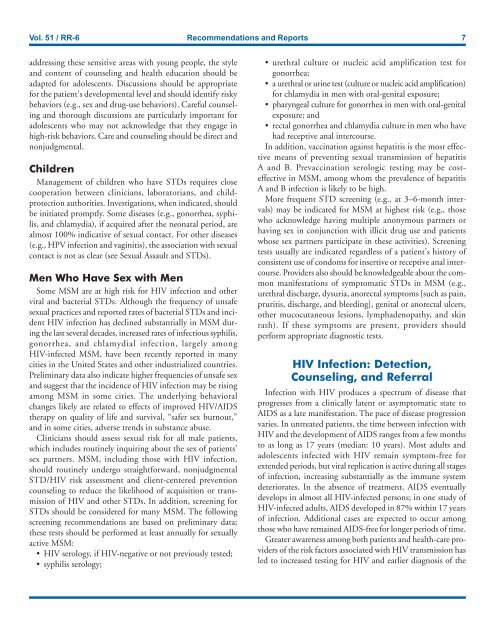You also want an ePaper? Increase the reach of your titles
YUMPU automatically turns print PDFs into web optimized ePapers that Google loves.
Vol. 51 / RR-6 Recommendations and Reports 7<br />
addressing these sensitive areas with young people, the style<br />
and content of counseling and health education should be<br />
adapted for adolescents. Discussions should be appropriate<br />
for the patient’s developmental level and should identify risky<br />
behaviors (e.g., sex and drug-use behaviors). Careful counseling<br />
and thorough discussions are particularly important for<br />
adolescents who may not acknowledge that they engage in<br />
high-risk behaviors. Care and counseling should be direct and<br />
nonjudgmental.<br />
Children<br />
Management of children who have STDs requires close<br />
cooperation between clinicians, laboratorians, and childprotection<br />
authorities. Investigations, when indicated, should<br />
be initiated promptly. Some diseases (e.g., gonorrhea, syphilis,<br />
and chlamydia), if acquired after the neonatal period, are<br />
almost 100% indicative of sexual contact. For other diseases<br />
(e.g., HPV infection and vaginitis), the association with sexual<br />
contact is not as clear (see Sexual Assault and STDs).<br />
Men Who Have Sex with Men<br />
Some MSM are at high risk for HIV infection and other<br />
viral and bacterial STDs. Although the frequency of unsafe<br />
sexual practices and reported rates of bacterial STDs and incident<br />
HIV infection has declined substantially in MSM during<br />
the last several decades, increased rates of infectious syphilis,<br />
gonorrhea, and chlamydial infection, largely among<br />
HIV-infected MSM, have been recently reported in many<br />
cities in the United States and other industrialized countries.<br />
Preliminary data also indicate higher frequencies of unsafe sex<br />
and suggest that the incidence of HIV infection may be rising<br />
among MSM in some cities. The underlying behavioral<br />
changes likely are related to effects of improved HIV/AIDS<br />
therapy on quality of life and survival, “safer sex burnout,”<br />
and in some cities, adverse trends in substance abuse.<br />
Clinicians should assess sexual risk for all male patients,<br />
which includes routinely inquiring about the sex of patients’<br />
sex partners. MSM, including those with HIV infection,<br />
should routinely undergo straightforward, nonjudgmental<br />
STD/HIV risk assessment and client-centered prevention<br />
counseling to reduce the likelihood of acquisition or transmission<br />
of HIV and other STDs. In addition, screening for<br />
STDs should be considered for many MSM. The following<br />
screening recommendations are based on preliminary data;<br />
these tests should be performed at least annually for sexually<br />
active MSM:<br />
HIV serology, if HIV-negative or not previously tested;<br />
syphilis serology;<br />
urethral culture or nucleic acid amplification test for<br />
gonorrhea;<br />
a urethral or urine test (culture or nucleic acid amplification)<br />
for chlamydia in men with oral-genital exposure;<br />
pharyngeal culture for gonorrhea in men with oral-genital<br />
exposure; and<br />
rectal gonorrhea and chlamydia culture in men who have<br />
had receptive anal intercourse.<br />
In addition, vaccination against hepatitis is the most effective<br />
means of preventing sexual transmission of hepatitis<br />
A and B. Prevaccination serologic testing may be costeffective<br />
in MSM, among whom the prevalence of hepatitis<br />
A and B infection is likely to be high.<br />
More frequent STD screening (e.g., at 3–6-month intervals)<br />
may be indicated for MSM at highest risk (e.g., those<br />
who acknowledge having multiple anonymous partners or<br />
having sex in conjunction with illicit drug use and patients<br />
whose sex partners participate in these activities). Screening<br />
tests usually are indicated regardless of a patient’s history of<br />
consistent use of condoms for insertive or receptive anal intercourse.<br />
Providers also should be knowledgeable about the common<br />
manifestations of symptomatic STDs in MSM (e.g.,<br />
urethral discharge, dysuria, anorectal symptoms [such as pain,<br />
pruritis, discharge, and bleeding], genital or anorectal ulcers,<br />
other mucocutaneous lesions, lymphadenopathy, and skin<br />
rash). If these symptoms are present, providers should<br />
perform appropriate diagnostic tests.<br />
HIV Infection: Detection,<br />
Counseling, and Referral<br />
Infection with HIV produces a spectrum of disease that<br />
progresses from a clinically latent or asymptomatic state to<br />
AIDS as a late manifestation. The pace of disease progression<br />
varies. In untreated patients, the time between infection with<br />
HIV and the development of AIDS ranges from a few months<br />
to as long as 17 years (median: 10 years). Most adults and<br />
adolescents infected with HIV remain symptom-free for<br />
extended periods, but viral replication is active during all stages<br />
of infection, increasing substantially as the immune system<br />
deteriorates. In the absence of treatment, AIDS eventually<br />
develops in almost all HIV-infected persons; in one study of<br />
HIV-infected adults, AIDS developed in 87% within 17 years<br />
of infection. Additional cases are expected to occur among<br />
those who have remained AIDS-free for longer periods of time.<br />
Greater awareness among both patients and health-care providers<br />
of the risk factors associated with HIV transmission has<br />
led to increased testing for HIV and earlier diagnosis of the


